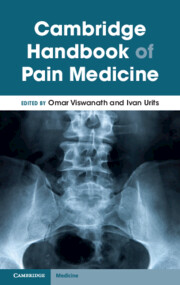Book contents
- Cambridge Handbook of Pain Medicine
- Cambridge Handbook of Pain Medicine
- Copyright page
- Contents
- Contributors
- Pain Handbook Introduction
- Part I Introduction to Pain: Pain Signaling Pathways
- Part II Common Categories of Pharmacologic Medications to Treat Chronic Pain
- Part III Chronic Pain Conditions Head and Neck
- Part IV Spine
- Part V Extremities
- Part VI Misc
- Chapter 26 Post-herpetic Neuralgia (PHN)
- Chapter 27 Complex Regional Pain Syndrome (CRPS)
- Chapter 28 Sickle Cell Disease
- Chapter 29 Breast Pain
- Chapter 30 Post-thoracotomy Pain
- Chapter 31 Multiple Sclerosis Pain
- Chapter 32 Cerebral Palsy
- Chapter 33 Myofascial Pain Syndrome
- Chapter 34 Post-stroke Pain
- Chapter 35 Chronic Abdominal Pain
- Chapter 36 Chronic Pelvic Pain
- Chapter 37 Postsurgical Nerve Entrapment
- Chapter 38 Cancer Pain
- Part VII Adjunctive Therapy
- Index
- References
Chapter 31 - Multiple Sclerosis Pain
from Part VI - Misc
Published online by Cambridge University Press: 01 December 2023
- Cambridge Handbook of Pain Medicine
- Cambridge Handbook of Pain Medicine
- Copyright page
- Contents
- Contributors
- Pain Handbook Introduction
- Part I Introduction to Pain: Pain Signaling Pathways
- Part II Common Categories of Pharmacologic Medications to Treat Chronic Pain
- Part III Chronic Pain Conditions Head and Neck
- Part IV Spine
- Part V Extremities
- Part VI Misc
- Chapter 26 Post-herpetic Neuralgia (PHN)
- Chapter 27 Complex Regional Pain Syndrome (CRPS)
- Chapter 28 Sickle Cell Disease
- Chapter 29 Breast Pain
- Chapter 30 Post-thoracotomy Pain
- Chapter 31 Multiple Sclerosis Pain
- Chapter 32 Cerebral Palsy
- Chapter 33 Myofascial Pain Syndrome
- Chapter 34 Post-stroke Pain
- Chapter 35 Chronic Abdominal Pain
- Chapter 36 Chronic Pelvic Pain
- Chapter 37 Postsurgical Nerve Entrapment
- Chapter 38 Cancer Pain
- Part VII Adjunctive Therapy
- Index
- References
Summary
Multiple sclerosis (MS) is an autoimmune disorder of the central nervous system, causing inflammation with oligodendrocyte death and myelin sheath destruction. Classical symptoms of MS are fatigue, paresthesia, motor deficits, cognitive dysfunction, visual disturbances (due to optic neuritis), spasticity, depression, gait disturbance, and pain. To make a formal diagnosis of MS, the 2017 McDonald criteria is used. Pain in MS can present itself as headache, extremity pain, back pain, neuropathic pain, or more specifically, trigeminal neuralgia. Pain in MS can be severe and chronic enough to cause disability and decreased quality of life. The prevalence of neuropathic pain in MS can be as high as 86% and it can manifest itself as back pain, headache, trigeminal neuralgia, or extremity pain. When present, it is associated with MS, which tends to be more severe, with a higher degree of disability. Early treatment of these pains leads to better outcomes of MS itself. Conventional methods to treat pain in these patients produce only a 50% reduction in symptomatology. Some unconventional treatment modalities that have benefited patients are antidepressants, anticonvulsants, cannabinoids, low-dose naltrexone, and spinal stimulation.
- Type
- Chapter
- Information
- Cambridge Handbook of Pain Medicine , pp. 248 - 252Publisher: Cambridge University PressPrint publication year: 2023



